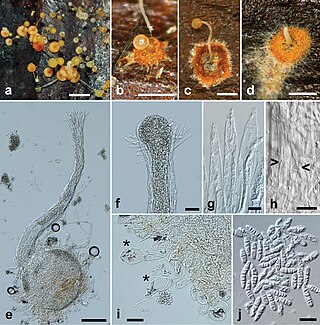The Cuniculitremaceae are a family of fungi in the order Tremellales. There are three genera in the family. Sterigmatosporidium polymorphum parasitizes other fungi growing in insect galleries in wood. It does not produce basidiocarps, but has septate basidia similar to those found in the genus Tremella. Most species are known only from their yeast states.
The Cystofilobasidiaceae are a family of fungi in the order Cystofilobasidiales. Phylogenetic analyses shows that this family is clearly distinct from other yeast-like families of the Tremellomycetes. The family currently contains the single genus Cystofilobasidium. Additional genera previously referred to the Cystofilobasidiaceae are now placed in the Mrakiaceae.

The Microbotryomycetes are a class of fungi in the subdivision Pucciniomycotina of the Basidiomycota. The class currently contains eight orders, plus three additional, unassigned families, plus seven additional, unassigned genera. Many species are known only from their yeast states. Species with hyphal states typically produce auricularioid basidia and are often parasitic on other fungi or plants. Several species in the genera Rhodotorula and Sporobolomyces are opportunistic human pathogens.
Trimorphomyces is a genus of fungi in the family Trimorphomycetaceae. The genus currently contains two species. The type species is a parasite of another fungus in the genus Arthrinium, forming small gelatinous basidiocarps containing distinctive twinned conidia.

The Heterogastridiales are an order of fungi in the class Microbotryomycetes. The order contains a single family, the Heterogastridiaceae, which currently contains five genera. Some species in the order are currently known only from their yeast states. Those producing hyphal states have auricularioid basidia and are parasitic on other fungi. Basidiocarps, when present, are minute and variously stilboid (pin-shaped), pustular, or pycnidioid (flask-shaped). Molecular research, based on cladistic analysis of DNA sequences, has shown that the order is a monophyletic (natural) group, though the type and only species of Krieglsteinera has not yet been sequenced and may belong elsewhere.
The Agaricostilbales are an order of fungi in the class Agaricostilbomycetes. The order consists of six families and 15 genera.
The Agaricostilbaceae are a family of fungi in the order Agaricostilbales. Basidiocarps (fruitbodies), where known, are stalked and capitate and produce spores on basidia that are laterally septate. Most species are known only from their yeast states. The family contains two genera.

Phaeotremella is a genus of fungi in the family Phaeotremellaceae. All Phaeotremella species are parasites of other fungi and produce anamorphic yeast states. Basidiocarps, when produced, are gelatinous and are colloquially classed among the "jelly fungi". Fifteen or so species of Phaeotremella are currently recognized worldwide. Tremella sanguinea, shown to be a Phaeotremella species by DNA sequencing, is cultivated in China as an ingredient in traditional Chinese medicine.
The Mrakiaceae are a family of fungi in the order Cystofilobasidiales. Phylogenetic analyses shows that this family is clearly distinct from other yeast-like families of the Tremellomycetes. The family had six genera in 2015.
Solicoccozyma is a genus of fungi in the family Piskurozymaceae. Species have only been isolated in their yeast states, several of which were formerly referred to the genus Cryptococcus, but can produce filamentous states with basidia in culture. Nine species have been described worldwide.
The Trimorphomycetaceae are a family of fungi in the order Tremellales. The family currently contains four genera. Some species produce filamentous sexual states and are parasites of other fungi. Most, however, are only known from their yeast states.
The Spiculogloeomycetes are a class of fungi in the subdivision Pucciniomycotina of the Basidiomycota. The class consists of a single order, the Spiculogloeales, together with an additional, unassigned genus, Meniscomyces. Many species are currently known only from their yeast states. Species in the genus Spiculogloea form hyphal states that produce auricularioid basidia and are parasitic on other fungi.
The Spiculogloeales are an order of fungi in the subdivision Pucciniomycotina of the Basidiomycota. The order is currently monotypic, consisting of a single family, the Spiculogloeaceae. Species in the genus Phyllozyma are currently known only from their yeast states. Species in the genus Spiculogloea form hyphal states that produce auricularioid basidia and are parasitic on other fungi.
The Cystobasidiaceae are a family of fungi in the order Cystobasidiales. The family currently comprises two genera, both of which contain fungal parasites with auricularioid basidia, some of which are known only from their yeast states.
The Cystobasidiales are an order of fungi in the class Cystobasidiomycetes. The order currently consists of a single family (Cystobasidiaceae) and two genera as yet unassigned to a family.
Platygloea is a genus of fungi belonging to the class Pucciniomycetes. Basidiocarps of the type species are disc-shaped, gelatinous, and occur on dead wood, probably as a saprotroph. Microscopically, all species of Platygloea sensu lato have auricularioid basidia. Currently the genus contains a heterogeneous mix of auricularioid fungi not yet accommodated in other genera.
Cystobasidium fimetarium is a species of fungus in the order Cystobasidiales. It is a fungal parasite forming small gelatinous basidiocarps on various ascomycetous fungi on dung. Microscopically, it has auricularioid basidia producing basidiospores that germinate by budding off yeast cells. The species is known from Europe and North America.
Occultifur is a genus of fungi in the family Cystobasidiaceae. Species are parasites of other fungi and, microscopically, have auricularioid basidia and basidiospores that germinate by yeast cells. Several species are currently only known from their yeast states. The genus is distributed worldwide.
The Colacogloeaceae are a family of fungi in the class Microbotryomycetes. Members of the family produce yeast states; hyphal states, where known, give rise to auricularioid basidia and are parasitic on other fungi.

Carcinomyces is a genus of fungi in the order Tremellales. Species are parasites of other fungi and produce anamorphic yeast states. Four species of Carcinomyces are recognized worldwide. The generic placement of a fifth species, Carcinomyces mycetophilus, is currently uncertain.




